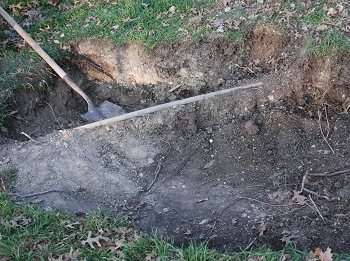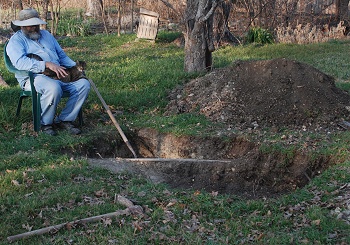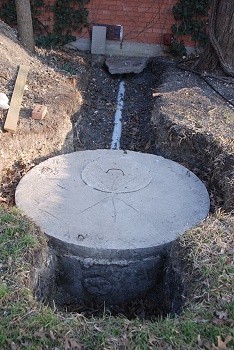So what’s been going on is four days of the Great Backyard Bird count (Friday through Monday) and unearthing the septic tank as well as the kitchen drain and grease trap, in preparation for having someone come out with a sewage sucking service to pump it out. Among the exciting discoveries in the archaeology project (along with bits of pipe and other things from earlier repairs and installations) was the rediscovery of the exact route of the electrical line from the service box to the outlet by the lily pond for the water garden pump.
Sometimes old-fashioned tools are better…at least, slower, so there’s time to think “What’s that funny white thing” before chomping a live electrical supply line in half. The chief excavator and his helper are taking a rest, below:
Later in the day, the entire top of the septic tank was uncovered and a trench begun around it to aid in getting the lids off without dropping dirt into the tank. (Yes, it has three slabs of concrete on the top. ) The cat is our old cat Cleo, who came to us as a frightened stray and turned out to be a superb mouser, ratter, and rabbiter in her younger days. It took years before she consented to being in the house at all, and still prefers to go out and drink from the pond rather than tap water in her bowl. We make sure she’s in at night and any time it’s cold or wet…though now she wants to come in after getting a drink and digging her own feline jacks and filling it in.
The previous project is now pretty much finished, at least in terms of excavation: the new drain line is in and working, and the grease trap is exposed for inspection.
Looks better than that first picture in the Paksworld Plumbing post, doesn’t it?
This morning various things kept me from doing what I’d planned. The afternoon was spent driving to the city and conferring with David Watson at New World Arbalest about making my own darning egg. (My mother had a small one. I can’t find it. Besides, it was pink. And David has a lathe and is going to teach me to use it.) We’ve picked a time (after Gulf War, the SCA event for which he is finishing a slew of crossbows and bolts, not the political situation) and a piece of wood (cherry.) Then we talked horses and writing too long and I was late down to the church for supper and choir practice, and on the way home needed to stop for milk.
Tomorrow the farrier comes early to trim Mac’s hooves. Mac, the drama queen. Mac is a very handsome fellow and knows it, and also knows that he should be admired and made much of and not asked to do anything but d/e/m/a/n/d/ accept handouts. So, as it’s almost midnight and I got home late from choir practice, as mentioned before. We had hoped the septic tank could be pumped out tomorrow, AFTER the farrier was through trimming Mac.but the septic tank guy was over in Marble Falls on an emergency and didn’t call when he got back, so the emergency may be ongoing. Maybe it can be pumped out Friday.
And that’s what’s going on here and why I haven’t written you folks another post or hunted up another snippet. It may still be a few days, sorry.



Comment by Naomi — February 20, 2014 @ 1:50 am
looks like Cleo is overseeing operations… good luck wit the ongoing works…my landlord finally decided to replace my single glazing windows and the work has been going on for the last 3 days, my four cats have taken up residence under the sofa…
Comment by GinnyW — February 20, 2014 @ 7:53 pm
That is a LOT of excavating. I hope the chief excavator is drinking plenty of fluids. The electric line is indeed a good reason to take the slow, laborious hand route. I hope the septic tank guy resolves the emergency, and you don’t have to wait too long.
Edges of our garden have emerged from the snow.
Comment by Nadine Barter Bowlus — February 20, 2014 @ 8:08 pm
Good luck with the plumbing project.
This Quilters Guildmember wonders if Paksworld has thrifty housewives who extend the life of bed covers by stitching the good bits from several old ones together? And if so, do some of them develop a parrion for turning homely and practical into beautiful and useful?
Comment by elizabeth — February 20, 2014 @ 10:25 pm
GinnyW: The chief excavator is staying hydrated. And the septic tank thing isn’t an emergency; it was excavated because it had been so long since it was pumped out, and thus it’s a preventive measure–let’s see where it is and pump it out so we can ignore it for another x-many years. As for spring, our Mexican plums are budded and should open blooms in the next few days; the elbowbush is blooming (and I saw on it one of my favorite little moths, the elegant Grapevine Epimenis, which I usually find on Mexican plums in bloom); the scarlet buckeye has exploded buds into a frill of leaves around emerging flower buds. Another cold front blew in, but it’s not supposed to be as cold.
Nadine: I don’t know, to be honest. I shall have to look more closely at bed-coverings the next time I’m inside a bedroom. My suspicion is that piecework quilting as an art form grows out of particular ways of making cloth (thread count, weaving styles), ideas about what you use on beds, importance of pattern-art, etc. But I could be wrong. I think whole-cloth quilting (to make quilted/padded garments and sometimes bedcoverings–for royal apartments, for instance–is more common, and most bed coverings are simply blankets, purpose woven of a different thread weight than clothes. Pieces cut from worn out garments are used to patch other garments. I simply haven’t been in enough bedrooms…too many inns and military barracks and upper-class bedrooms, not enough everyday house bedrooms in enough places. For that matter, I don’t know the history of piecework quilting, worldwide…got a source for me? I need to understand the full context. (I do know that in some cultures garments are not made in such a way that scraps result…the full width of material is used; shaping–if any–results from how the cloth is wrapped or tied or belted.)
Comment by Linda — February 20, 2014 @ 10:28 pm
All the best with the septic system … I suspect I may be doing something similar come May … or whenever the deep, deep snow melts and the ice comes out of the ground.
Cleo sounds like a most excellent cat. Long ago I had a Cleocatera … a remarkable feline with a special talent for soothing her person in moments of stress.
Comment by Confutus — February 21, 2014 @ 3:00 am
From what I can see with a quick glance, patchwork quilting has arisen in India and in Western Europe, and possibly other places. In Europe, a major factor was the colder climate about the 14th century, when warm blankets and bedding became more important than they had been earlier, although there was a Southern European influence on elaborate design. The art of quilting was brought to the United States along with the Pilgrims, and remained very much alive with cold northern winters.
I am also aware, without needing to look it up, that the craft flourished in various American pioneering communities that struggled with cold winters and poverty, as a way of recycling clothing that was too worn out to patch or mend.
Housewives could and did get quite creative about how they reused old clothing, but Dolly Parton’s “Coat of Many Colors” was more commonly a patchwork quilt or a rag rug.
When “Use it up, wear it out, make it do, or do without” was not just frugality but necessity, and especially before the advent of cheap machine-made cloth, the recycling of every scrap was more common and important than it is now.
Comment by GinnyW — February 21, 2014 @ 7:33 am
I may be wrong, but I read somewhere that quilting (for skirts, vests, and other decorative clothing) may have evolved from patching old clothing. That is, the effect of patching together pieces of cloth in an attractive way became a desirable thing, rather than a sign of extreme necessity. The scraps would come from garments that were worn through in some but not all places.
The ability to use available materials to the fullest extent, and especially to use them to create an appealling environment seems to have driven a number of crafts. When you consider the amount of effort that goes into hand spinning thread or yarn, then weaving into cloth, it is not surprising that people would use the resulting cloth for as long as possible.
Comment by Peter — February 21, 2014 @ 3:15 pm
Nice pictures of the excavation but where are the results to your GBBC?
Please don’t tease the birder! (Birders? anyone?)
Comment by Daniel Glover — February 21, 2014 @ 3:48 pm
Linda,
I just got done dealing with several controlled avalanches–off the east end of my roof. So weather one can dig trenches in is still many weeks away. This is horse nomad country, not Aarenis.
Comment by pjm — February 21, 2014 @ 7:24 pm
Excavating instead of posting, therefore post holes.
I am glad everything seems to have gone successfully. Even the weather is improving. Ours is too, but moving down from hot 30 and 40 with risk of bushfires to the more comfortable 20s.
Peter
Comment by Nadine Barter Bowlus — February 21, 2014 @ 9:14 pm
Are the bandas the soldiers wear at practice stitched in some way to keep the padding from shifting? If so, “quilting” exists in Paksworld.
Comment by elizabeth — February 21, 2014 @ 10:09 pm
Nadine: not usually, as they’re stuffed with straw usually (not all bandas are made the same–some are stuffed with rags or the less valuable parts of fleeces, or hair from hair sheep or goats–whatever’s available and cheap in that area. Think “baseball base”. Some are quilted, but many are not–depends on the stuffing and its tendency to shift. It’s often easier to rip out one seam, pull out the worn out beaten-up stuffing, and shove more stuffing in.) Quilting does exist–I mentioned “whole garment quilting”–common for fancy doublets, for instance, more warmth and elegance than protection from sharp pointy things. A wealthier merchant’s winter robe will likely have quilting on the upper part. But pieced quilting, especially the kinds of designs I’ve seen (as opposed to “crazy” or “rag” quilting)…that’s what I’m not sure of.
There was a quilting guild in this small town when we moved here–I gave them a bunch of fabric in my mother’s stash after my mother died–and from them, and a friend that quilted, and attending some quilting shows, it seems that most use fabrics of the same weight and often same weave within one quilt–and patterned, printed fabrics are very popular for this kind of quilting. Paksworld does not have printed fabrics; it does have woven patterns (and quite elaborate ones if you have the money for them) but nothing equivalent to the kinds of fabrics I’ve seen most in quilts. The quilting I’ve “seen” in homes is not nearly as fancy as what we usually think of. The quilt stuffing may simply be “tied” at intervals (not actual seems, just thread run through, often with a little round piece of wood like a button on one side) or the pieces of the quilt top may be squares or odd shapes of fabric with no attempt at real design. The stuffing may be an old blanket (I actually had a quilt like that given to me–the inside was an old blanket, with a patterned sheet on one side, and pieced work on the other, but it was just squares and rectangles sewn into strips and then the strips sewn side by side. It appeared random. I liked it but my mother thought it was very crude. It was a good quilt to put on the ground for a picnic.
Comment by Confutus — February 22, 2014 @ 2:35 am
It depends on the materials available, skill of the quilter, and their motives. Three of my four great grandmothers were raising large families in rather marginal rural areas far from large cities, and were the daughters of pioneers and original settlers. My grandparents were born in the early 20th century and were raising families during the Depression. I have memories of my mother and grandmothers examining old garments and carefully ripping the seams out (rather than crudely cutting the garment apart) in order to conserve fabric and get enough pieces of the proper size for the design they were planning. I was just old enough to help a little with that part. It seems that color was more a consideration than weight or type of fabric. I don’t recall that they worked from a published pattern: rather, it seems, they would adapt an existing example according to the material they had to work with. I remember the quality of stitching and tying being an issue in the discussions I overheard, and a quilt was more often a job for four or more women than one, so there were established community traditions and techniques. I am reasonably certain that their teachers back for generations had done similarly.
Comment by GinnyW — February 22, 2014 @ 9:26 am
I inherited a lambswool comforter which is essentially two sheets sewn into a bag around a layer of carded, but not spun or woven lambswool. Then a second cover of some kind of calico over that, which was tied with heavy thread. The original cover disintegrated, but the rest is still usable, and very, very warm. I can picture Paks’ mother having such covers on the beds in the far northwest of Tsaia. The filling does not seem to shift the way down does.
Comment by elizabeth — February 22, 2014 @ 10:17 am
I think the “old blanket inside other fabric” must be a variation on that–but surely, if you have sheep and shear them (and esp. if the wool doesn’t fetch a good price) you’d use it yourself one way or another. Makes perfect sense to use carded wool like that.) (Yes, I will EVENTUALLY go out and shovel dirt today…as in next post.)
Comment by Nadine Barter Bowlus — February 22, 2014 @ 7:53 pm
Modern day Japanese quilters are doing wonderful things using traditional “peasant” fabrics–muted, mostly earth tones, with lots of woven stripes, plaids, and textures. Thats the sort of thing I had in mind when I asked about patchwork.
Comment by Richard — February 23, 2014 @ 6:13 am
Peter (#8), birders are sometimes “twitchers”, but I believe this is a derogatory term used by birders themselves for the sort of birder who will travel hundreds of miles to a rare siting, but will completely lose interest in the bird once ticked off in the spotter’s field guide, and who holds common species in contempt.
Comment by Richard — February 23, 2014 @ 6:17 am
Typo there – more slip of the brain than slip of the fingers – “rare sighting”.
Comment by elizabeth — February 23, 2014 @ 6:55 am
Peter: The whole septic tank excavation/pumping out/shoveling dirt back has delayed getting the list in proper order but I’ll share it when I have it. All the birds were expected sightings except the peregrine falcon–we see one just about every year, but not usually close in, sitting in a tree in the yard. R- saw that; I was out on the land, out of sight. Darn it.
Partial list: * denotes winter resident only; ** denotes non-native
Blue Jay
Carolina Chickadee
Black-crested Titmouse
*American Goldfinch
Lesser Goldfinch
*House Finch (one pair year round, extras in winter)
*White-crowned Sparrow
*Harris’s Sparrow
*Chipping Sparrow
*Fox Sparrow
White-winged Dove
Inca Dove
Turkey Vulture
Black Vulture
Red-tailed Hawk
*Peregrine Falcon
Mockingbird
Cardinal
Ruby-crowned Kinglet
Tri-colored Blackbird (migrant)
**Starling
**House Sparrow
**Eurasian Collared Dove
The Roadrunner–year-round resident–seen every few days did not put in an appearance during the GBBC. Ditto the Sharp-shinned Hawk or the Cooper’s Hawk, winter residents; the Cooper’s showed up the next day. I heard but did not see some Cedar Waxwings, and heard but did not see one of the winter-resident flycatchers on a blurry sort of morning.